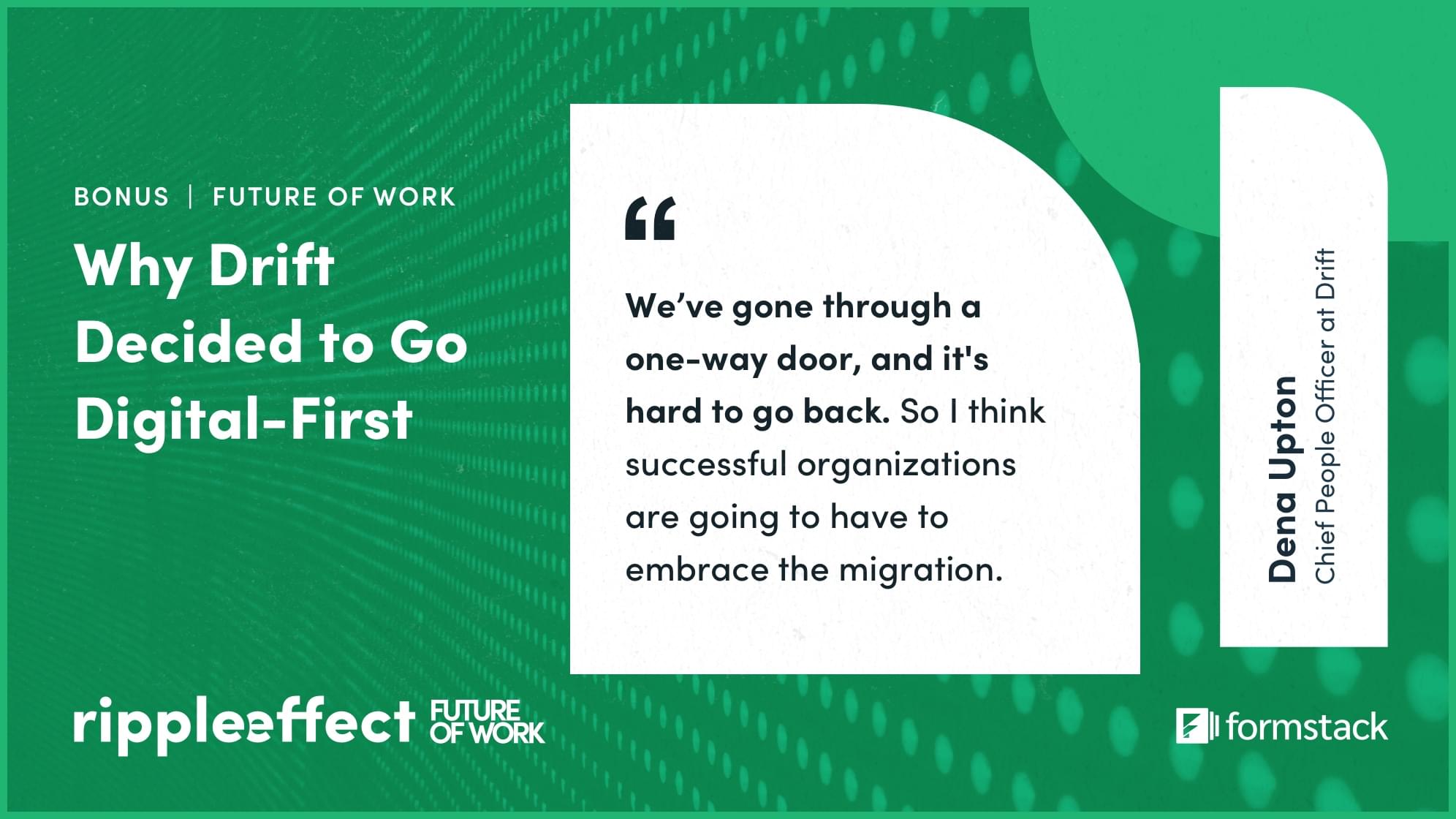After the last year and a half, it can be hard to think back and remember a time when most people did not work from home. But it wasn’t that long ago that remote work was much more of a rarity.
In fact, go back three years to 2018, and only 5 million U.S. employees (3.6% of the U.S. workforce) worked from home half-time or more, according to Global Workplace Analytics. Before the COVID-19 pandemic, many organizations resisted or flat out refused to let their employees work remotely—even though 80% of employees would prefer to work from home at least part of the time.
But when faced with a worldwide pandemic, organizations had to pivot and break away from their hard-and-fast rules on remote work. Many businesses that never even considered allowing their employees to work remotely had to quickly shift to a digital-first, fully remote strategy.

For most, this change came on swiftly, without much time to consider policies, procedures, or impact on culture. As Chief People Officer at Drift, Dena Upton was one of millions of HR professionals who had to navigate this change. On a recent episode of Formstack’s Ripple Effect podcast, Dena explains how Drift was a fully in-office culture before the pandemic and why they’ve chosen to step away from this model for a digital-first approach.
But what does digital-first mean? We’ll explain that next, as well as provide strong digital-first strategies that can make remote work efficient, equitable, and enjoyable for all employees.

Want to listen to Dena's Ripple Effect podcast now? Check out Future of Work: Why Drift Decided to Go Digital-First!
What is a digital-first work culture?
You have probably heard of remote, hybrid, and in-office work models. But Drift has come forward with something a bit different: a digital-first approach. What does this mean? Let Dena explain:
In a digital-first work model, employees have set expectations that a majority of their time will be spent working remotely. This differs from a hybrid approach, where employees have little to no regulations on using office space. For Drift, it was important to establish this digital-first approach to create an equitable working environment for all employees.
“Our founders had a past company that was a hybrid model, and it created an inequitable experience for individuals. So those people that were remote missed out on hallway conversations or missed out on a quick impromptu meeting that sometimes can happen at headquarters. And so we didn't want an inequitable experience for people as we're starting to recruit people from outside of those hub locations.”
For Drift, the shift from fully in-office to digital-first has produced lots of learnings. Below, we dig into some of the best practices Dena has discovered as she’s helped the team transition from a typical office environment to a digital-first approach.
How to Build a Strong Digital-First Work Culture
If your organization is assessing what the future of work holds, you may want to consider this new digital-first approach. Even if your organization has already made the decision to go hybrid or remote, the digital-first strategies below can help keep employees engaged, productive, and happy.
Set Expectations
Whether you go in-office, hybrid, remote, or digital-first, it’s important to set clear expectations of all employees so they can fully understand the vision for the next chapter of work. This is especially important if your organization is changing from one work type to another post-pandemic.
Building a strong foundation for what is expected will ensure all employees have an equitable experience. Will you require cameras to be on during meetings? Should an agenda always be included in meeting invites? Can meetings only be set on certain days? What tools do teams use to communicate, meet, and share information? Setting expectations for all of these areas of work will create a better work environment, make employees more efficient, and help everyone collaborate seamlessly in a digital-first world.
Embrace a Digital Footprint
Providing employees with the right tools and technology can make all the difference when it comes to working remotely. It’s also important to train employees on the technology provided to ensure everyone knows how to best use the digital tools at their disposal. For instance, employees may need to know how to stream a video with sound over Zoom.
Whether you need to expand, reassess, or develop your tech stack, here are some crucial tools to have available to create a strong digital work environment:
- Video conferencing
- Instant messaging
- Digital workflows
- Cloud storage
- Secure email
- Project management
- Online forms
- Intranet
When digging into new tools or technology to help your team adjust to remote, digital-first, or hybrid work, it’s important to keep your organization size in mind. Some tools work just fine for teams of hundreds or thousands, while others are unable to support a single workforce of that size.

Pro Tip: Use our Digital Transformation Checklist to learn how to select the right technology for your organization, gather buy-in from leadership, and launch successfully.
Create a Culture Deck
If your organization had never worked remotely before COVID-19, this tip can be very helpful in making the transition.
Many organizations struggle to maintain culture when they shift from fully in-office to any type of remote working, whether it be hybrid, remote, or digital-first. Creating a culture deck will allow your organization to easily define how it maintains its culture in a digital-first world.
Lay out your organization's mission, vision, description, and culture values in a PowerPoint or similar visual presentation. Then define how these areas will be supported through virtual culture building, whether that’s through virtual events, employee recognition, one-on-one Zoom chats, interactive activities, holiday celebrations, or other ways to build culture virtually.
When people can quickly and easily understand how they can bond and build relationships virtually, they can jump right into building and supporting a strong virtual work culture.
Consider Your Pay Structure
One thing Dena discusses in her Ripple Effect episode is how to pay employees who work remotely. Although organizations vary on how they approach this complicated topic, many take two things into consideration: location and performance.
Some companies, like Drift, will turn to market data within a location to get a grasp on competitive salaries for a role within a specific area. They will then combine this data with a more general, role-specific salary base to build salary bands.
Dena expects that in the future, we will begin to see location-based salary data go down for many cities—like San Francisco, New York, and other large cities—as people begin to explore other areas outside the typical work hot spots.
Embracing the Next Chapter of Work
No matter what changes, adaptations, or pivots your employer is putting into place going forward, having a plan matters. Now that we have time to focus on strategies and execution, it’s important to take a step back to evaluate what works best for your workforce.
Whether you end up going remote, hybrid, in-office, or digital-first, it’s important for all organizations to adapt to the digital-first world around us. Regardless of your office status, the world has changed over the past year, and there’s no going back now. We hope the tips above help guide your organization as we all prepare for the next year and beyond.
Hear more tips on how Drift has implemented a successful digital-first strategy by listening to the Ripple Effect episode Future of Work: Why Drift Decided to Go Digital-First now.











